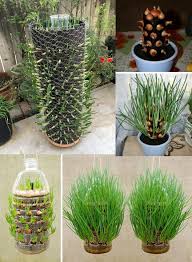Vertical gardening is a smart and efficient way to grow onions, especially in small spaces. By building an onion tower, you can enjoy a fresh, abundant harvest while maximizing limited gardening areas. This method not only saves space but also promotes better air circulation and sunlight exposure, leading to healthier plants and larger yields. Here’s a detailed, step-by-step guide on how to build and maintain an onion tower in your own garden.
Benefits of an Onion Tower
- Space Efficiency: Ideal for small gardens, urban balconies, or even patios, where ground space is limited.
- Reduced Pest and Disease Risk: Elevating onions off the ground minimizes exposure to pests and soil-borne diseases, ensuring healthier crops.
- Ease of Maintenance and Harvesting: Vertical towers make it simpler to water, monitor plant health, and harvest without needing to bend or stoop.
Materials Needed
- A vertical tower planter (commercially available or DIY)
- High-quality potting mix
- Compost or well-rotted manure
- Onion sets (small bulbs) or onion seeds
- Watering can or drip irrigation system
- Optional: Mulch like straw or wood chips
Step 1: Choose and Prepare Your Tower
- Select a Tower: You can buy a vertical tower planter or create your own using materials like PVC pipes, plastic bottles, or fabric grow bags with side pockets. The tower should be sturdy enough to hold the soil and plants without tipping over.
- Positioning: Place your tower in a sunny spot that receives at least 6 hours of direct sunlight each day. Ensure it is stable and will not fall over when filled with soil and onions.
Step 2: Soil Preparation
- Mix Your Soil: For optimal onion growth, mix high-quality potting soil with compost or well-rotted manure to enrich the soil. Onions require nutrient-rich, well-draining soil to thrive.
- Fill the Tower: Carefully fill the tower with the prepared soil mixture. Distribute the soil evenly to avoid over-compression, which can restrict root growth.
Step 3: Planting the Onions
- Using Onion Sets: Plant onion sets about 1 inch deep, spacing them 4-6 inches apart. The tips of the bulbs should just peek through the soil’s surface.
- Using Seeds: If you’re starting from seeds, sow them about ¼ inch deep. Once the seedlings reach a few inches tall, thin them out, leaving only the strongest ones to grow.

Step 4: Watering and Maintenance
- Watering: Keep the soil moist, but avoid overwatering. A drip irrigation system is an excellent way to ensure your onions receive consistent water without waterlogging the soil.
- Feeding: Every few weeks, feed your onions with a balanced liquid fertilizer to encourage healthy growth and robust bulbs.
- Pest and Disease Monitoring: Check your onion tower regularly for signs of pests or disease. Remove any affected plants promptly to prevent the issue from spreading.
Step 5: Harvesting the Onions
- When to Harvest: Your onions are ready for harvest when their tops begin to yellow and fall over. Gently loosen the soil around the onions and lift them out of the tower.
- Curing the Onions: After harvesting, place your onions in a warm, dry area with good air circulation to cure. This step hardens the outer layers, preparing the onions for storage.
Aftercare and Seasonal Considerations
- Post-Harvest: After harvesting, refresh the soil in your tower with fresh compost or organic matter to prepare for the next planting cycle.
- Winter Care: In areas with frost, move the tower to a sheltered spot or cover it with horticultural fleece to protect your onions from cold damage.
By following these steps and maintaining your onion tower, you can enjoy fresh, flavorful onions grown in even the smallest of spaces. This innovative gardening method not only saves space but also ensures a healthier, more abundant harvest. Happy gardening!
